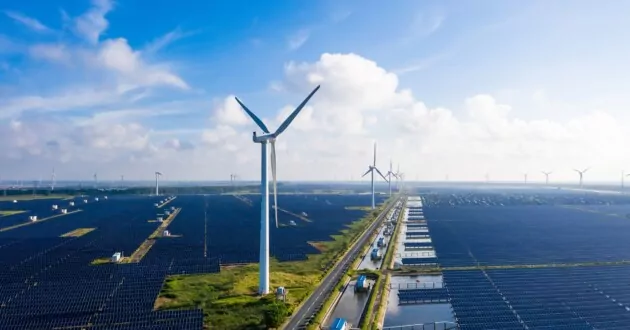<!—->
<!– –>

The term ESG, or environmental, social and governance, is well-known in the investor community. It refers to a set of metrics used to measure an organization’s environmental and social impact and has become increasingly important in investment decision-making over the years. But while the term ESG was first coined in 2004 by the United Nations Global Compact, the concept has been around for much longer.
The roots of responsible investment
In the 1970s, socially responsible investing (SRI) emerged as a way for investors to align their portfolios with their values. This movement gained momentum in the 1980s with the divestment campaigns against companies doing business in South Africa during apartheid. Over time, SRI steadily evolved to look much like today’s corporate social responsibility (CSR) and was focused primarily on social issues such as human rights and supply chain ethics.
However, it wasn’t until the 1990s that ESG considerations started to appear in mainstream investment strategies. In 1995, the U.S Social Investment Forum (SIF) Foundation took inventory of all the sustainable investments in North America. The total—$639 billion—shed light on how shareholders were starting to invest out of principle versus strictly profit.1
Slowly but surely, institutional investors started to recognize that companies could potentially improve financial performance and risk management by focusing on ESG issues like greenhouse gas emissions. In response, asset managers began to develop ESG strategies and metrics to measure the environmental and social impact of their investments. In 1997, the Global Reporting Initiative (GRI) was founded with the aim of addressing environmental concerns, though it soon broadened its scope to also focus on social and governance issues.
In 1998, John Elkington published, Cannibals with Forks, the Triple Bottom Line of 21st Century Business, in which he introduced the concept of the triple bottom line, a sustainability framework that revolves around the three p’s: people, planet and profit. Elkington’s goal was to highlight a growing body of non-financial considerations that should be included when valuating companies. Moreso, Elkington hoped to persuade businesses to operate in the best interest of people and the planet; a desire that was shared by others around the world.
ESG at the turn of the millennium
In 2000, the United Nations hosted world leaders in New York at the Millennium Summit to discuss their evolving role in the new millennia. Over the course of the three-day summit, leaders established guiding principles around topics like human rights, working conditions, the environment and anti-corruption. Following the summit, the Millennium Development Goals (MDGs) were created, outlining eight international development goals to be achieved by 2015. While meant to spark discussion, the MDGs ultimately set the stage for nations and corporations to discuss ESG factors more candidly.
That same year, the Carbon Disclosure Project (CDP) was founded. The CDP encouraged institutional investors to ask companies to report on their climate impact. This helped normalize the practice of ESG reporting and by 2002, 245 companies had responded to the 35 investors who asked for climate disclosures.2
In 2004, the term “ESG” became official after its first mainstream appearance in a report titled, “Who Cares Wins.” The report illustrated how to integrate ESG factors into a company’s operations, breaking down the concept into its three basic components: environmental, social and governance (or corporate governance).
In the decade that followed, more principles and frameworks were created, providing further guidance on how companies can integrate and report on ESG factors. Some prominent examples include the Principles for Responsible Investment (PRI), the Climate Disclosure Standards Board (CDSB) and the Sustainability Accounting Standards Board (SASB). Today, companies and investors still rely on these principles and frameworks.
The last decade: an evolving landscape
By 2015, the Sustainable Development Goals (SDGs) replaced the MDGs. The SDGs outlined seventeen sustainability targets and set a global agenda for sustainable development with the hopes of improving quality of life and achieving a more sustainable future by 2030. While broader in their scope, the SDGs set specific targets—169, to be exact—with unique indicators to track progress. With their adoption, the SDGs marked a shift in the socio-political mindset; ESG was no longer a talking point but something that could (and should) be measured.
Investors continued to demand climate-related financial disclosures from companies, so regulators responded with new reporting requirements. The Taskforce on Climate-related Financial Disclosure (TCFD) was founded in 2015 with the goal of providing standards for climate-related disclosure for financial institutions, as well as companies and investors.
Later, in 2017, a group of 140 CEOs gathered to sign the Compact for Responsive and Responsible Leadership (the Compact) which was drafted by the World Economic Forum. The signatories committed to working together to help achieve the UN’s SDGs—a pledge that would be put to the test come 2020.
When the COVID-19 pandemic hit, many investors feared that companies would forego their ESG initiatives for the sake of staying afloat. And while this was the case in some instances, an interesting discovery was made: companies that had strong ESG performance were better equipped to weather the pandemic as they had already accounted for the possibility of disruption.3
ESG today and tomorrow
ESG is no longer a fringe concept but a household initialism for both companies and investors. Today, ESG data is used to evaluate a company’s performance on specific ESG issues. For instance, carbon emissions per unit of revenue are used to evaluate a businesses’ environmental impact, while employee turnover rates are used to evaluate a company’s labor practices.
Asset managers continue to develop a range of ESG strategies and metrics to measure the environmental and social impact of today’s companies. Some strategies focus on excluding industries or organizations that do not meet certain ESG criteria. Others focus on actively selecting companies that have strong ESG profiles.
New regulations have been established, like the European Union’s Corporate Sustainability Reporting Directive (CSRD) which requires businesses to report on the environmental and social impact of their business activities, and on the business impact of their ESG efforts. In North America, the Securities and Exchange Commission (SEC) is considering mandatory ESG reporting for public companies, as is the case in Canada, Brazil, India, Australia and Japan.
ESG ratings and indices have also become more prevalent in recent years. Morgan Stanley Capital International (MSCI), for example, offers a range of ESG indices that allow investors to track companies based on their ESG performance. These indices have become popular with investors looking to integrate ESG factors into their portfolios.
As the world faces increasing challenges related to climate change and social issues, ESG considerations will continue to play a critical role in the way companies and investors operate and measure their performance.
Simplify the capture, consolidation, management analysis and reporting of your ESG data with IBM Envizi ESG suite.
1. Report on US Sustainable and Impact Investing Trends (link resides outside ibm.com), US SIF, 2020
2. CDP Media Factsheet (link resides outside ibm.com), CDP, October 2022
3. Connecting the COVID-19 pandemic, environmental, social and governance (ESG) investing and calls for ‘harmonisation’ of sustainability reporting (link resides outside ibm.com), Critical Perspectives on Accounting, Adams, Abhayawansa, 28 February 2022
Was this article helpful?
YesNo
More from Sustainability

February 8, 2024
The history of climate change
6 min read – Tackling global climate change and tracking greenhouse gas emissions has become an all-hands-on-deck endeavor. The World Bank recently launched an initiative, in collaboration with NASA and the European Space Agency, to collect and organize satellite-based measurements of concentrations of greenhouse gases in the atmosphere.1 Back on Earth’s surface, companies around the world are also tracking greenhouse gas emissions—the ones produced by their businesses and value chains. Some are using software tools to gauge their progress in achieving reductions in carbon…

February 8, 2024
The history of renewable energy
7 min read – Renewable energy is critical to combatting climate change and global warming. The use of clean energy and renewable energy resources—such as solar, wind and hydropower—originates in early human history; how the world has harnessed power from these resources to meet its energy needs has evolved over time. Here’s a quick look at how different forms of renewable power generation evolved to diversify the global energy sector and the world’s energy supply. Solar energy Efforts to harness the power of the…

February 7, 2024
Sustainability trends: 5 issues to watch in 2024
5 min read – In 2024, sustainability is taking center stage. Efforts to track and reduce emissions, environmental impact and contributions to climate change are no longer rare or optional; instead, they’ve become the norm. Businesses, governments and individuals now see sustainability as a global imperative. Advanced technologies, more stringent reporting standards and stronger support from stakeholders are building momentum for eco-friendly initiatives and the incentives that encourage them. Here’s what to watch: Net zero: The race moves forward The global focus on achieving…

February 5, 2024
Transforming the future: A journey into model-based systems engineering at Singapore Institute of Technology
5 min read – In the dynamic cityscape of Singapore, a pioneering initiative is unfolding at the Singapore Institute of Technology (SIT). A group of 56 students has embarked on a unique journey into the world of model-based systems engineering (MBSE). Under the mentorship of Marco Forlingieri, associate faculty member at SIT and ASEAN Engineering Leader from IBM Singapore, students engaged in a hands-on exploration of IBM® Engineering Systems Design Rhapsody®. This course stands as Singapore’s only dedicated MBSE academic offering. IBM: Not only…
IBM Newsletters
Get our newsletters and topic updates that deliver the latest thought leadership and insights on emerging trends.
Subscribe now
More newsletters
- SEO Powered Content & PR Distribution. Get Amplified Today.
- PlatoData.Network Vertical Generative Ai. Empower Yourself. Access Here.
- PlatoAiStream. Web3 Intelligence. Knowledge Amplified. Access Here.
- PlatoESG. Carbon, CleanTech, Energy, Environment, Solar, Waste Management. Access Here.
- PlatoHealth. Biotech and Clinical Trials Intelligence. Access Here.
- Source: https://www.ibm.com/blog/environmental-social-and-governance-history/



